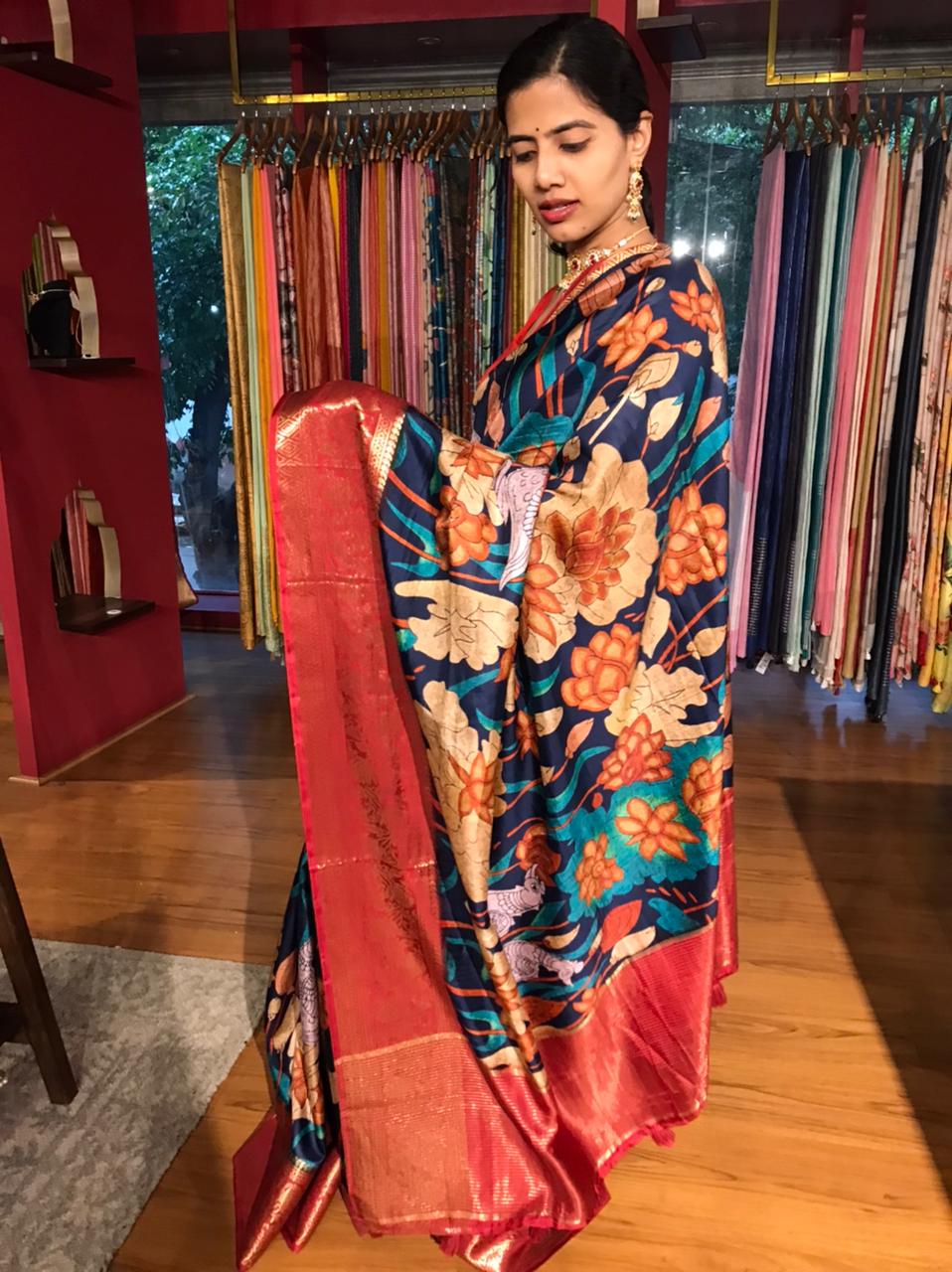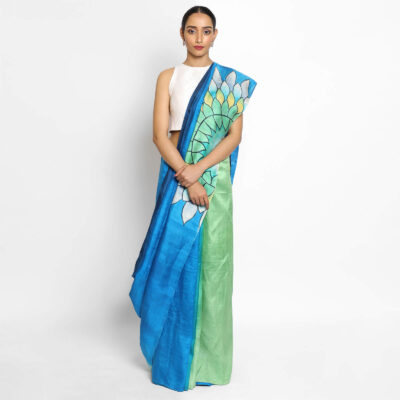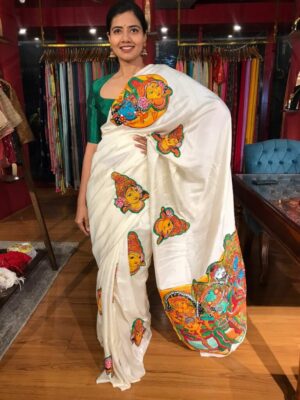Artistic Expressions: Handcrafted and Handloom Sarees

India is known for its vibrant culture, rich traditions, and diverse art forms. One such form of art that has stood the test of time is handcrafted sarees. These sarees are not just a piece of clothing but a representation of India’s heritage and cultural significance.
Handloom Sarees: Weaving Stories of Tradition
Handloom sarees are made using traditional weaving techniques passed down from generation to generation. Each region in India has its unique style of weaving, producing sarees with intricate designs and patterns. The process involves manually weaving threads to create beautiful sarees that are a true work of art.
Types of Handloom Sarees
Some popular types of handloom sarees include Banarasi, Kanjeevaram, Chanderi, Tussar, and Pochampally. Each type has its distinct characteristics and is named after the place where it originated. For example, Banarasi sarees hail from Varanasi in Uttar Pradesh and are known for their intricate zari work and opulent designs.
Weaving Process
The process of making handloom sarees is a labor-intensive one and involves various stages. It begins with the selection of high-quality yarn, which is then dyed in various colors using natural dyes. The yarn is then loaded onto a loom and handwoven to create the base fabric.
Once the base fabric is ready, skilled weavers use traditional techniques like Jamdani, Bandhani, or Patola to add intricate designs to the saree. These designs are woven into the fabric using different colored threads, making each saree unique.
Significance
Handloom sarees hold immense cultural significance in India. They are not just an essential part of a woman’s wardrobe, but they also serve as a symbol of pride and identity. For centuries, handloom sarees have been worn during special occasions like weddings, festivals, and religious ceremonies.
Moreover, the production of handloom sarees provides employment to millions of weavers, especially in rural areas. It is an important source of income for many families and helps in preserving traditional weaving techniques.
Challenges Faced
Despite their cultural significance and popularity among buyers, handloom sarees face various challenges. The rise of power loom machines and the availability of cheaper synthetic fabrics have affected the demand for handloom sarees. This has impacted the livelihood of weavers and threatened the existence of this traditional art form.
Revival Efforts
To revive the handloom saree industry, various government initiatives have been taken, such as providing financial assistance to weavers, organizing exhibitions and fairs to showcase their products, and promoting handloom sarees on a global scale.
Moreover, many designers have also started incorporating handloom fabrics into their collections, giving them a modern touch while keeping the essence of traditional weaving intact. This has helped in creating a demand for handloom sarees among younger generations.
Hand-Painted Sarees: Wearable Art
Hand painted sarees, also known as Pattachitra sarees, are a form of wearable art. These sarees are hand-painted by skilled artisans using natural dyes and pigments to create stunning designs inspired by nature, mythology, or historical events. Each saree tells a story and is a perfect blend of traditional art and modern fashion.
History and Origin of Hand Painted Sarees
The history of hand painted sarees can be traced back to the 8th century in Odisha, India. Pattachitra, which translates to “patta” meaning cloth and “chitra” meaning painting, is a traditional form of art that originated in the village of Raghurajpur. The artisans from this village have been creating stunning pattachitra paintings on cloth for centuries, with each generation passing down their skills and techniques to the next.
Unique Features of Hand Painted Sarees
Hand painted sarees are known for their intricate designs, vibrant colors, and unique storytelling. The artisans use a combination of techniques such as freehand painting, block printing, and stencil work to create these masterpieces. They also incorporate elements like gold and silver zari threads to add a touch of luxury to the sarees.
The Making Process of Hand Painted Sarees
The process of making a hand painted saree is labor-intensive and requires great skill and patience. Firstly, the saree fabric is washed and treated with natural dyes to create a base color. Then, the design is sketched on the saree using charcoal or chalk. The artists then start hand painting the saree using natural pigments, which are extracted from plants, minerals, and even cow dung. Once the painting is complete, the saree is dried and ironed to set the colors.
Popular Themes in Hand Painted Sarees
Hand painted sarees often depict scenes from Hindu mythology such as Krishna playing his flute or Lord Shiva performing Tandava. They also feature elements of nature like flowers, birds, and animals. Some artisans also create abstract designs or geometric patterns on their sarees.
Kalamkari Sarees: The Heritage of Storytelling through Fabric
Kalamkari is an ancient form of textile art that originated in Andhra Pradesh. It involves hand-painting or block printing intricate designs on cotton or silk fabric using natural dyes. Kalamkari sarees are not just pieces of clothing but a medium to narrate stories through art, making them unique and culturally significant.
Ikat Sarees: The Intricate Art of Resist Dyeing
Ikat is a technique of resist dyeing where the threads are dyed before weaving, creating precise patterns and designs on the fabric. These sarees require immense skill and precision to create intricate designs, making them one of the most sought-after handcrafted sarees in India. The result is a stunning piece of art that reflects traditional techniques and modern designs.
The Cultural Significance of Handcrafted Sarees
Handcrafted sarees hold immense cultural significance in India. They are worn on various occasions, including weddings, festivals, and religious ceremonies. Each saree has its unique story to tell, representing the diverse cultures and traditions of different regions in India.
Preserving the Art: Supporting Artisan Communities
With the rise of machine-made sarees, handcrafted sarees face the risk of becoming an endangered art form. To preserve this tradition and support artisan communities, it is essential to promote and buy handcrafted sarees. Organizations like Mirra Clothing are dedicated to promoting handcrafted sarees by providing a platform for artisans to showcase their skills and sustain their livelihood.
Where to Find the Right Handcrafted Saree for Your Style
If you’re looking for unique and authentic handcrafted sarees, Mirra Clothing is the perfect destination. They offer a wide range of contemporary and fusion sarees, including Kalamkari, hand-painted, ikat, and handloom sarees. Each saree is carefully crafted by skilled artisans, making them one-of-a-kind pieces that reflect the beauty of Indian art and culture.

